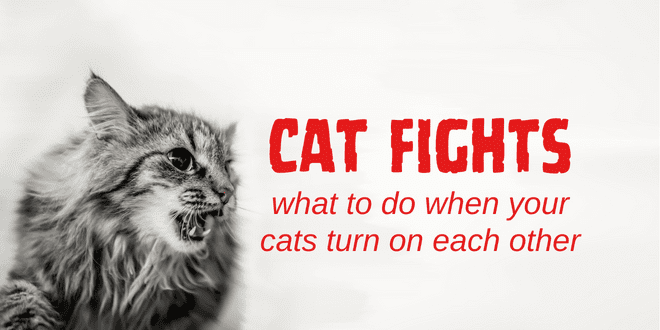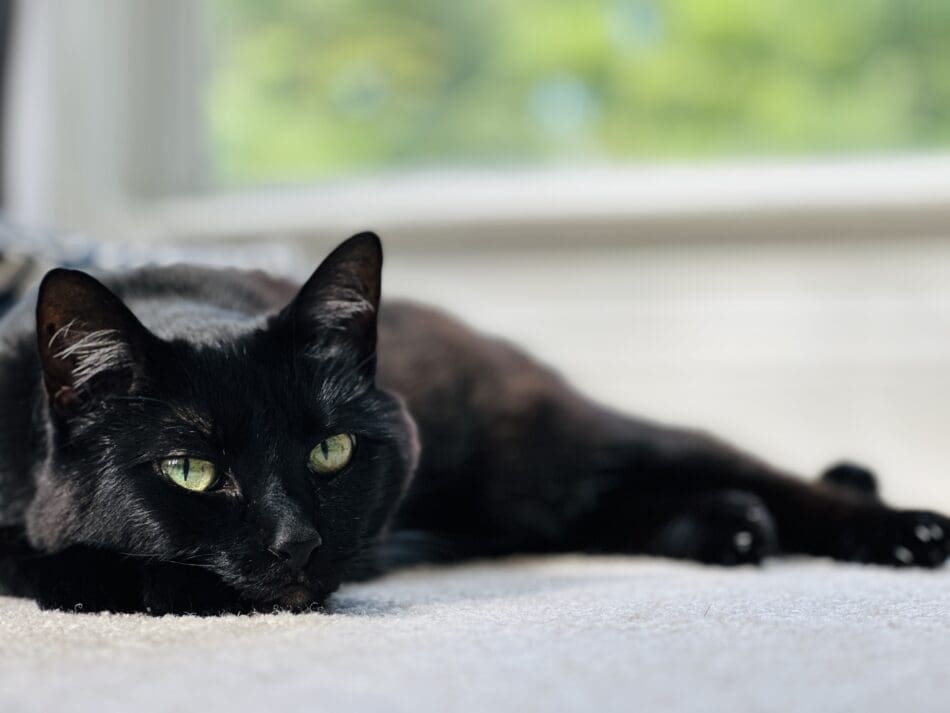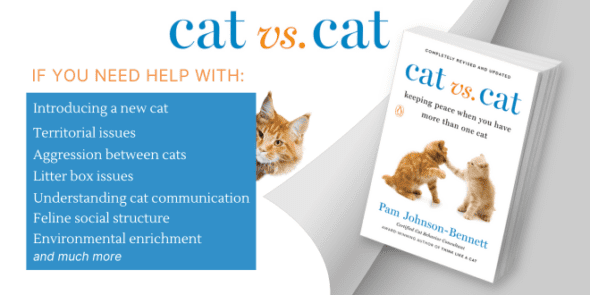
It can be very confusing and frustrating when companion cats who have previously lived together in harmony, suddenly decide to engage in a turf war. In some cases, the cats have lived under one roof with an ongoing degree of tension that has now turned to outright hostility and aggression. Cat parents become understandably upset when watching their feline family turn the living room into a battlefield.
Intercat Aggression
I’ve found in my consultations that many cat parents don’t always recognize the fact that their cats aren’t getting along with each other because there are no overt signs of aggression. The cats might not be engaging in an outright battle with fur flying and bloodshed so some people miss the subtle signs of tension. Keep in mind that cats generally prefer to not engage in an actual physical confrontation and that’s why they go to elaborate attempts at posturing. Each cat is hoping that their puffed-up, tough-looking posture will convince their opponent to back off. There can also be some intimidation going on that’s just under the radar where one cat engages in behavior such as guarding the path to the litter box or nosing another cat out of the food bowl. Not all companion cats are going to get along 100% of the time; just as with people, there are bound to be some misunderstandings and miscommunication, but if you notice a pattern of intimidation, there may be more stress between your cats than you originally thought.
Then there are the cases where there’s no mistaking the fact that your cats don’t get along in any way. Growling, hissing, and physical brawls may have become a part of daily life in your household. If this is the case, don’t wait it out with the hope the cats will eventually reach an understanding. This level of aggression will only get worse. It’s time to help them negotiate a peaceful resolution.
Find the Cause of the Aggression Between Your Cats
In order to resolve the aggression between your cats you have to identify the underlying cause. If the aggression is sudden and uncharacteristic then there could be an underlying medical cause. Any time there’s a change in behavior your cat should be examined by the veterinarian in order to rule out possible medical causes. One cat might be experiencing pain or has developed arthritis and that may be causing the aggression toward the other cat. Visit your veterinarian because this is an important step that shouldn’t be skipped.
If the cats had previously gotten along but have suddenly become enemies then redirected aggression may also be a possible reason. One cat may have spotted an unfamiliar animal outside and redirected that frustration and reactivity in the form of aggression toward a companion cat. If one cat visited the veterinarian and then was attacked by a feline companion upon returning home, then that might be non-recognition aggression. There are different types of aggression and many causes so you need to sharpen your detective skills in order to uncover the trigger.
Make Some Changes to the Cats’ Environment
When the relationship between the cats is tense but doesn’t seem serious or dangerous, then you may be able to begin a behavior program to help them feel more at ease with each other. This involves creating an environment that inspires security as well as doing some behavior work. Just wishing the cats will get along or punishing them for reacting to each other will do nothing but continue the downward spiral. It’s time to make some changes in the environment and create positive associations.

Photo: Pam Johnson-Bennett
Sharing Isn’t Always a Good Thing When it Comes to Cats
Look at the cats’ living environment and see what you can do to create more safe zones and security. Social structure in cats is centered around the availability of resources. You may need to look around see if you’ve unintentionally put your cats in a position of having to compete for resources.
For example, perhaps the cats have been sharing one food bowl and you notice they tend to compete for access. Each cat should have their own food bowl. In some cases, the feeding stations need to be separated as well so the cats don’t see each other. Cats aren’t social eaters so putting them close together during meals can create unnecessary tension.
Another thing to look at is the litter box. Have the cats been sharing one box? The rule of thumb is to have the same number of litter boxes as you have cats plus one extra for good measure. It might be time to place another litter box in the home. Location of the box will matter as well so place that other box in an entirely different room. This way, one cat won’t have to cross the other cat’s path when it’s time to eliminate. In a multicat environment, litter boxes should be located in each cat’s preferred area.
The same rule applies, to scratching posts. Since one aspect of scratching is a marking behavior, don’t ask the cats to share one post if there’s tension between them. Place more than one post in the house. Even though you can’t dedicate a particular post to a certain cat, you are offering them the ability to make the choice to share or not. Place posts in socially significant areas as well as near perimeters (for example, near entry doors).
Make sure each cat has a choice when it comes to accessing resources. Offering choice in your environment can go a long way when it comes to keeping stress at bay. This applies to feeding stations, litter boxes, scratching, places to nap, as well as interaction with others.
Cats Need Vertical Territory
If you’re at all familiar with my work or have attended any of my conference lectures, you’ve heard me say that we live in a horizontal world but cats live in a vertical one. You have some prime real estate within your home that isn’t being used – real estate that just may make a difference in whether you have a happy cat household or an unhappy one.
You can increase vertical territory in so many ways. If the budget allows, you can go over the top and create amazing vertical space or you can do very cost-effective changes. Your cats will appreciate any vertical enhancements as long as they’re safe, secure, and comfortable.
Vertical territory gives the cats some safe places to perch and oversee their territory. For a very assertive cat it can be a way of displaying their confidence. By claiming the highest perch in the area, it may be enough of a display so that a cat doesn’t feel the need to engage in aggression. For a fearful cat, it can be a safe place to nap so that they aren’t at risk of being ambushed from behind. The cat has more visual warning time to see if an opponent is approaching. Even in a shelter cage environment, the ability for a cat to be off the cage floor creates security. A hammock bed suspended in the cage or a shelf attached to the cage wall helps. That’s how important vertical territory is in a cat’s world. On the fun side, vertical territory is great for watching the birds outside, napping in the sun, climbing, and playing.

Photo: Pam Johnson-Bennett
One of the quickest and easiest ways to create vertical territory is by purchasing a multi-leveled cat tree. A multi-leveled one makes it easier for a less mobile cat to be able to access the top perch. The multi-levels can also create enough space so that two cats may be willing to share the tree without competition.
Vertical territory can also be created by installing cat shelves on the wall or attaching window perches to a few choice windows. Cat walkways, cat stairways, and wall perches are wonderful enrichment additions. Just make sure there is more than one way to exit so you don’t create a dead end perch where a cat can be ambushed. Even a cat bed on a book shelf increases the cat’s real estate. Look around your house and I’ll bet you can find lots of inexpensive and homemade ways to increase your cat’s vertical environment.
Make Positive Associations for the Cats
The behavior aspect of helping your cats become friends again involves giving them a reason to like each other. Create positive associations. Provide opportunities for good things to happen when they’re in the presence of each other. Maybe they get treats when they’re together.
Be aware of giving equal amounts of attention so one cat isn’t favored over the other. You may be upset with the one cat whom you feel is initiating the aggression but it’s important to show each cat an equal amount of attention.
Playtime is a Valuable Tool When it comes to Cat Behavior
Use playtime as a behavior tool. Conduct individual interactive play therapy sessions so each cat has chances during the day to focus exclusively on being a hunter and can enjoy the game. Do these sessions separately so the cats don’t have to worry about each other. In addition, conduct parallel playtime sessions so the cats can play “together” but not have to compete for one toy. If there’s another family member available, have them play with one cat while you play with the other. The cats will see that they’re in the room together but no one is doing any intimidation. If you don’t have another family member to help, you can still do parallel play by holding a fishing pole-type toy in each hand. It’s awkward at first but you’ll get more adept at it with practice.
Solo playtime is also a valuable behavior modification tool. If the cats have something to focus their attention on other than each other, it may ease the tension. Cats are hunters and they’re born to be active. If you provide an enriched environment by providing opportunities for discovery, hunting, and reward, they get to work off energy with less of a chance of it building up into something destructive.
For solo play you can use puzzle feeders. There are many food-dispensing toys available on the market or you can create your own. These are a great way to provide some fun activity for each cat during the day where they get a reward for their hard work. You can also create other puzzle toys to keep your cats busy. A little ball in an empty tissue box or a crinkly little toy in an open paper bag are a couple of simple ideas. There are also several cat puzzles available at your pet product store or online that can be very entertaining.
Clicker Training Your Cats
This is another valuable tool you can use when dealing with two cats who are not getting along. Clicker training involves the use of a little sound-generating device that makes a cricket-type noise when you press it with your finger. The sound of the clicker can be used to mark the behavior your want from your cat. By pairing the sound of the clicker with a food reward, the cat will learn to associate the clicker with something positive. This way, you can reward the cat for any positive behavior – however small. For example, you can click and reward a cat for walking by a companion cat. If they normally would hiss or growl and they just walked by, that deserves some positive recognition. You can even click for something as minor as one cat walking into the room where the other cat is sitting. Clicker training gives the cat a road map of what behavior will result in a good consequence.
Be Calm to Help Your Cats Remain Calm
How you behave can have an influence on your cats’ reactions to each other. If you’re tense when they’re together because you anticipate something awful happening, they’ll pick up on that. If you punish a cat for reacting to a companion cat then that will do nothing to help them find a reason to like each other. Be calm so your furry little emotional cat sponges will hopefully be calm as well.
When Things Go Horribly Wrong Between Your Cats
What do you do if the relationship between your cats is so serious that there’s a risk of someone getting injured? What if they can’t even be in the same room together for one second without a battle erupting? Then it’s time to do a reintroduction. There are times when the best way to heal the relationship involves starting from scratch. Instead of continuing to go down the current road which clearly isn’t working, it’s better to separate the cats and introduce them again as if they had never met.
If the situation is too serious or you’re afraid of the cats then it’s time to talk to your veterinarian about a referral to a certified behavior expert. The behavior expert will be able to evaluate the cats and the environment so they can provide you with a detailed, customized behavior treatment plan.
Things Won’t Change Overnight
Be patient. When you’re helping your cats change their association with each other it will take time. Unless you’re dealing with a redirected aggression episode then chances are this relationship didn’t deteriorate overnight so it won’t be healed overnight.
Need More Information?
Contact your veterinarian if your cat has had a change in behavior of has started displaying aggression. A examination in needed to rule out possible underlying medical issues. Your veterinarian can also give you a referral to a qualified behavior professional.
For more information on cat behavior and training, refer to the books by Pam Johnson-Bennett. Pam’s books are available at bookstores and online. We’ve included links to Amazon here on our website.
If you have a question regarding your cat’s health, please contact your veterinarian. This article is not intended as a replacement for your cat’s veterinary care.


